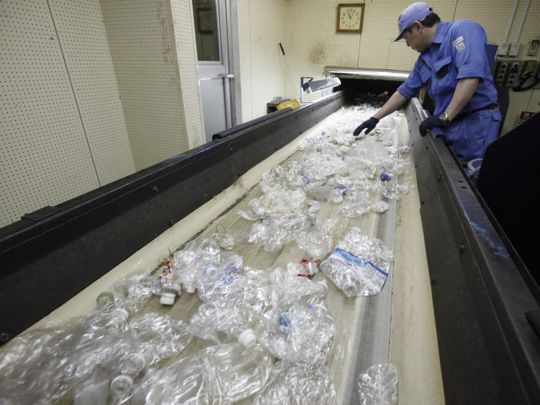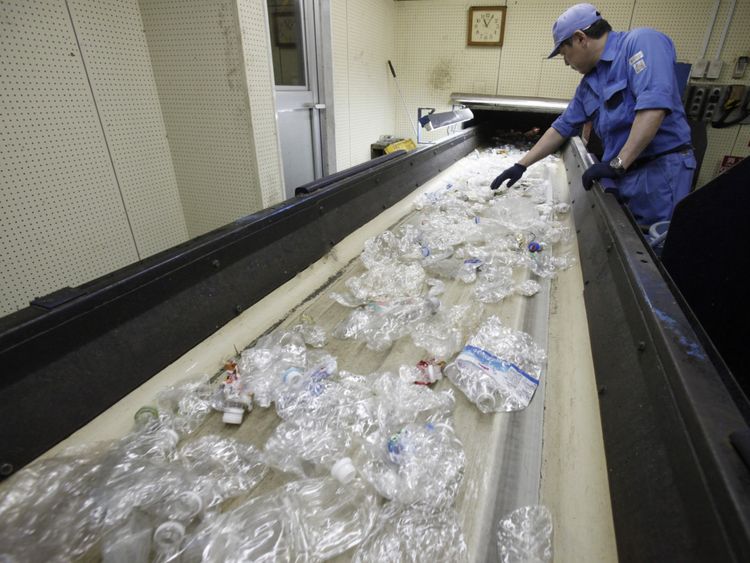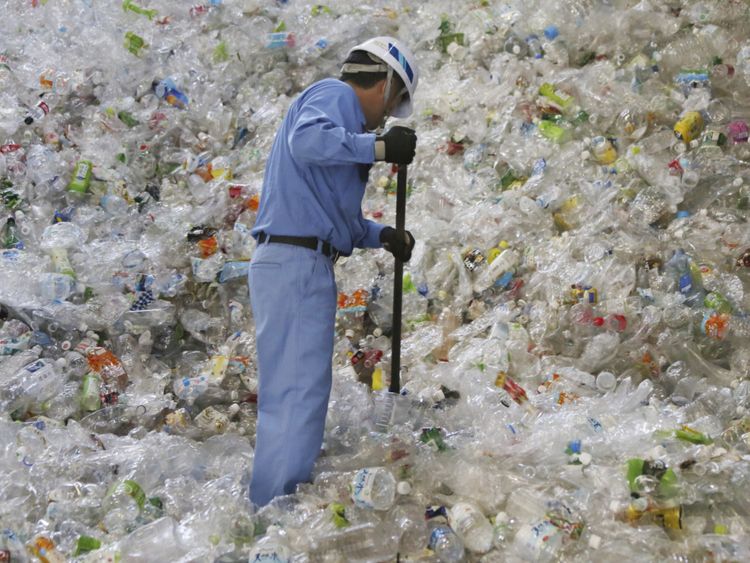
OSAKA, Japan - Shoji Kousaka always thought of Japan as a place where people knew how to dispose of their trash.
That was before he spent a morning on a fishing trawler in Osaka Bay last fall, shocked by the reams of soda bottles, plastic shopping bags, snack wrappers and drinking straws repeatedly trapped in the nets, along with the flounder and shrimp.
“Things that weren’t supposed to be there, were there,” said Kousaka, deputy chief of the Union of Kansai Government, a regional federation representing the second-largest metropolitan area in Japan after Tokyo. Based on what he saw in six hours on the boat, Kousaka estimates more than 6.1 million plastic scraps and about 3 million plastic bags sit on the floor of the bay.
Given Japan’s high collection rate for plastic waste and the country’s rigorous approach to recycling, said Kousaka, “I was surprised at how much trash was at the bottom of the ocean.”
As world leaders flew in for the Group of 20 summit in Osaka recently, they met in a conference center about a mile from the bay where Kousaka discovered the offending plastic.
Reducing the plastic waste that flows into the oceans was a critical proposal by Prime Minister Shinzo Abe of Japan at the G-20 meeting.
Single-use plastic bottles and utensils were banned from the international media center, and reporters received gift bags that included a cup made from recycled plastic, imprinted with a cartoon of a crying turtle paddling beside a floating water bottle, straw and grocery bag. “Let’s protect the ocean from plastic waste!” read the caption.
According to scientific estimates, the 20 countries generate about half of all marine plastic litter, which has the potential to destroy ecosystems, obstruct navigation and befoul beaches.

Critics have already assailed the measures for lacking any numerical reduction targets. But experts and advocates say the G-20 measures at least keep marine plastic waste in the public eye.
“It’s useful in that it maintains the issue on the top of the international agenda,” said Torbjorn Graff Hugo of the International Law and Policy Institute in Oslo, who has written about the need for an international treaty to control marine plastic waste. “And this group of countries is using the opportunity to reinforce their commitment to do something about this.”
For Japan, the world’s second-largest generator of plastic packaging waste per person behind the United States, the problem is more than proper disposal.
The Japanese are often praised for their meticulous trash collection - remember the World Cup soccer fans who cleaned up all their cups and wrappers before they left the stadium? - and can be extremely careful about separating waste for recycling.
But plastic consumption is deeply embedded in Japanese culture, where vegetables sold in grocery stores are individually wrapped, packages are often double-bagged and ubiquitous vending machines dispense plentiful plastic bottles.
While most municipalities have sophisticated collection systems - somewhere between 70% and 80% of used plastic wrappers, bottles and bags are collected by waste management companies and then recycled or incinerated - Japan’s Environment Ministry estimates that between 20,000 and 60,000 tons of plastic waste end up in the ocean each year.
In talking about marine plastic litter, Abe has mainly pushed for improvements in trash collection and recycling rather than a substantial reduction in the total amount of plastic the Japanese use.
“We’re not really tackling the source of the problem,” said Karen Raubenheimer, a lecturer at the University of Wollongong in Australia and an expert in marine plastic policy. “If you’re only talking about collection and waste management, you’re not talking about reduction of production and consumption.”
Chiyoko Yamada, 72, shopping in a basement food court at the Kintetsu Department Store in Osaka, filled her basket with plastic-swathed groceries. There were plastic food containers of fried soba noodles and savory pancakes known as okonomiyaki, filled with individual plastic sachets for each ingredient. A sole carrot sheathed in plastic wrap rolled around at the bottom of her basket next to four spears of asparagus, also wrapped in plastic.
“I think all that plastic is excessive,” Yamada said. “It just creates a lot of work for me at home unwrapping every individual thing.”
Japan’s track record on marine waste is mixed; at the Group of 7 meeting in Canada last year, it did not sign a plastics charter aimed at reducing marine waste. The only other country that did not sign was the United States.
Globally, one of the biggest problems is that developed nations offload their trash by exporting it to poorer countries that may not have sophisticated recycling systems.
“It’s the big lie,” Raubenheimer said. “Yes, we say we are recycling so much, but how much are we recycling domestically, and when we send it overseas, there is no way of tracking that.”
Two years ago, China, which had been a major destination for exported waste, banned most plastic trash shipments. Now countries like Japan are shipping their plastic to countries in Southeast Asia. Because the recipients lack the capacity to recycle it all, more plastic waste ends up in the sea.
At the same time, developing countries are increasing their use of plastic, often as part of a program to improve food safety and hygiene.
Experts warn that the drive to reduce plastic use could pose risks to the health of citizens in poor countries.
“If all plastic is removed from the world, children may get more diseases from polluted dishes and forks,” said Atsuhiko Isobe, a professor at the Research Institute for Applied Mechanics at Kyushu University, who has studied marine plastic waste.
He agrees with the goal of reducing plastic consumption, he said, but it should be done “step by step and in line with scientific evidence.”
“Plastic has a risk to the natural environment,” he said, “but simultaneously, removing plastic also has a risk to the world.”
New York Times News Service
















